Decay in nature can be seen from different points of view. On the one hand, to decay just means to die or more literally to rot. This is not a pleasant process, but a process that cannot be stopped and must take place according to the natural way of life/the laws of nature. On the other hand, decay does not only have this negative connotation because to decay in nature also means that something new is developing out of the dead material. Only when something, like an apple for example, dies, a new generation of apples can arise.
These two different points of view are shown in the poems “’Tis the Last Rose of Summer” by Thomas Moore (1779-1852) and “On Observing a Large Red-streak Apple” by Philip Freneau (1752-1832).
Inhaltsverzeichnis (Table of Contents)
- Decay in Nature
- “Tis the Last Rose of Summer” by Thomas Moore
- The Last Rose of Summer
- The Lyrical I
- The Sorrow of the Lyrical I
- “On Observing a Large Red-streak Apple” by Philip Freneau
- The Red-streak Apple
- The Lyrical I and Nature
- The Cycle of Life and Death
Zielsetzung und Themenschwerpunkte (Objectives and Key Themes)
This essay examines two poems by Thomas Moore and Philip Freneau, both of which explore the theme of decay in nature. The essay analyzes the poems’ poetic devices, imagery, and themes to demonstrate how the authors present different perspectives on the process of decay.
- The concept of decay in nature
- The use of imagery and poetic devices to convey mood and meaning
- The portrayal of death as a natural process
- The relationship between human life and the natural world
- The role of the lyrical I in each poem
Zusammenfassung der Kapitel (Chapter Summaries)
“Tis the Last Rose of Summer” by Thomas Moore
This section analyzes Thomas Moore's poem "Tis the Last Rose of Summer." The essay examines the poem's structure, poetic devices, and imagery to illustrate how Moore portrays the theme of decay and the passing of time. The poem's melancholic tone is emphasized through the use of personification, anaphora, and dark vowels. The lyrical I's sympathy for the dying rose and its contemplation of death are central themes.
“On Observing a Large Red-streak Apple” by Philip Freneau
This section examines Philip Freneau's poem "On Observing a Large Red-streak Apple." The essay analyzes the poem's structure, language, and themes to demonstrate how Freneau portrays the theme of decay in nature. The poem's more optimistic tone is contrasted with Moore's melancholic perspective. The lyrical I's observations on the apple and its reflections on the cycle of life and death are explored.
Schlüsselwörter (Keywords)
This essay focuses on the themes of decay, death, nature, poetic devices, imagery, lyrical I, and the different perspectives of Thomas Moore and Philip Freneau on these topics. The analysis includes discussions of personification, anaphora, euphemisms, and other stylistic devices used in the poems.
- Quote paper
- Kathrin Ehlen (Author), 2006, Decay in Nature - Seen from Two Different Points of View, Munich, GRIN Verlag, https://www.grin.com/document/173793
-

-

-

-
Upload your own papers! Earn money and win an iPhone X. -

-
Upload your own papers! Earn money and win an iPhone X. -

-
Upload your own papers! Earn money and win an iPhone X. -

-
Upload your own papers! Earn money and win an iPhone X. -

-
Upload your own papers! Earn money and win an iPhone X.

